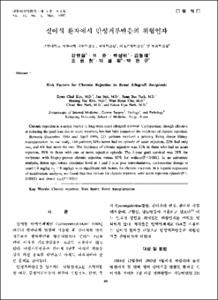KUMEL Repository
1. Journal Papers (연구논문)
1. School of Medicine (의과대학)
Dept. of Internal Medicine (내과학)
신이식 환자에서 만성거부반응의 위험인자
- Keimyung Author(s)
- Kim, Hyun Chul; Park, Sung Bae; Kim, Hyoung Tae; Cho, Won Hyun; Park, Choal Hee; Park, Kwan Kyu
- Department
- Dept. of Internal Medicine (내과학)
Dept. of Surgery (외과학)
Dept. of Urology (비뇨의학)
Dept. of Pathology (병리학)
- Journal Title
- 대한이식학회지
- Issued Date
- 1997
- Volume
- 11
- Issue
- 1
- Abstract
- Chronic rejection is a major barrier to long-term renal allograft survival. Cyclosporine, though effective at reducing the graft loss due to acute rejection, has had little impact on the incidence of chronic rejection.
Between December 1984 and April 1995, 221 patients received a primary living donor kidney transplantation. In our study, 154 patients(70%) never had an episode of acute rejection, 22% had only one, and 8% had more the one. The incidence of chronic rejection was 12% in those who had no acute rejection, 39% in those with one or more rejection episode. The 5-year graft survival was 28% for recipients with biopsy-proven chronic rejection versus 83% for without(P <0.001). In an univariate analysis, donor age, serum creatinine level at 1 and 2 year post transplantation, cyclosporine dosage at year( < 4 mg/kg vs >= 4 mg/kg) were significant risk factors for chronic rejection. In a logistic regression of multivariate analysis, we found that risk factors for chronic rejection were acute rejection episode(P < 0.0001) and donor age(P<0.01).
- Alternative Title
- Risk Factors for Chronic Rejection in Renal Allograft Recipients
- Publisher
- School of Medicine
- Citation
- 김현철 et al. (1997). 신이식 환자에서 만성거부반응의 위험인자. 대한이식학회지, 11(1), 49–53.
- Type
- Article
- ISSN
- 1598-1711
- 파일 목록
-
-
Download
 oak-bbb-03228.pdf
기타 데이터 / 265.14 kB / Adobe PDF
oak-bbb-03228.pdf
기타 데이터 / 265.14 kB / Adobe PDF
-
Items in Repository are protected by copyright, with all rights reserved, unless otherwise indicated.